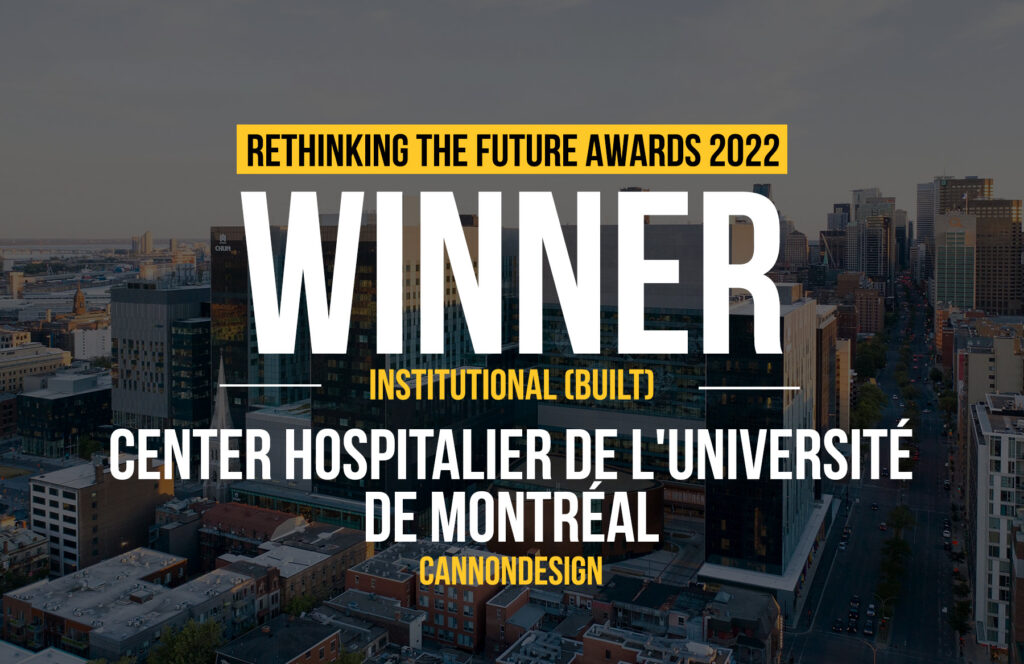When approaching the new CHUM, the first thing people notice is its size; it’s visible from almost every vantage point within Montreal. People then notice how the clouds dance across the glass. How the architecture beautifully juxtaposes historic and new.
Rethinking The Future Awards 2022
First Award | Institutional (Built)
Project Name: Centre hospitalier de l’Universite de Montreal (CHUM)
Studio Name: CannonDesign + NEUF architect(e)s were the design architects for the full medical campus and the implementation architects for phase 1 (which included 85% of the program). The revision of the Phase 2 design, the execution of the plans and specifications, and the construction supervision for the final phase was performed by Jodoin Lemarre Pratte architectes / Menkes Shooner Dagenais LeTourneux architects.
Design Team: More than 400 people made important contributions to the design of the CHUM. Here’s just a few of the key individuals:
CannonDesign + NEUF architect(e)s [design architect and phase 1 architect]
Andrew King, Jose Silva, Gustavo Lima, Azad Chichmanian, Christy Cavataio, Elizabeth Rack, Simon Bastien, Nicolay Boyadjiev, Sergio Clavijo, Andrew Chung, Chris Ilg, Allen King, Lilia Koleva, Charles-André Laviolette, Jean-Louis Léger, Jeffrey Ma, Shaheen Namvary, Julia Pascutto, Jocelyn Stroupe, Jean-François Trahan, Elizabeth Van den Brink
Jodoin Lemarre Pratte architectes / Menkes Shooner Dagenais LeTourneux architects [phase 2 architect]
Michel Broz, Anik Shooner, Jean-Pierre LeTourneux, Joanne Parent, Martine Gévry, Georges Assaker, Annie-Pier B.-Bastien, Corinne Bédard-Ouimet, Juan Benavides, Yien Chao, Jérôme Courtemanche, Jonathan Davidson, Tanya De Bellefeuille, Marilou Desjardins, Charles-Edouard Dorion, Julie Dupuis, Jassy Favreau, Maude Frenette-Roy, Sylvain Gagné, Maxime Gagnon, Philippe Girard, Marc-Antoine Grondin, Fahed Hammami, Véronique Hébert, Bellessa Jargstorff, Klaudia Konieczny, Marie-Ève Labat, Claude Labbé, Ariane Latendresse, Simon Lecavalier, Daniel Litalien, Laurianne Marotte, Nicolas Mazzilli, Aziz Mehand, Olivier Millien, Sylvie Morin, Christine Nolet, Claudia Pace, Marie-Ève Poulin, Roxanne Rochette, Gaetan Roy, Marcelo Sànchez, Emily Whitcher, Sammy Yehia, Mahindar Youssef
Area: 3.5 million SF
Year: Full project completition in 2021
Location: Montreal, Quebec, Canada
Consultants:
- Phase 1: Construction— Construction Santé Montréal (Laing O’Rourke and OHL Canada); Engineers—Pasquin St-Jean, HH Angus, Groupe SM; Landscape architects—NIPpaysage.
- Phase 2: Construction—Pomerleau; Engineers—SDK et associés, FNX-INNOV, Pageau Morel et associés; Landscape architects—NIPpaysage.
Budget: 2 billion CAD$
Image credits: Adrien Williams and Olivier Gariépy
How the design integrates monumental works of modern art. How it’s catalyzing new development in all areas surrounding the once overlooked site. And most importantly, how it’s delivering a level of world-class healthcare never seen in Quebec.
While new healthcare buildings are continually opening across the globe, none match the CHUM. It’s a 21-story. 3.5 million-SF urban academic medical center bringing healthcare, research, history and culture together in one of the most vibrant cities in the world.
The CHUM story begins with its site, which is located along St. Denis Street, one of the most famed streets in Canada. The two blocks the CHUM occupies are on what was once an underused stretch of the street, between the history-laden district of Old Montreal and the culturally rich Latin Quarter. The CHUM now acts as a binder between these important districts, connecting them with a dynamic new area known as the Quartier de la Santé: Montreal’s new health district.
CHUM responds to its urban site by presenting buildings that vary in scale and articulation while maintaining a common language of materials and façade strategies. A “three towers” concept allows for a massing that is sympathetic to the neighborhood and identifiable in form and character from key vantage points within the city. It also simplifies wayfinding as each of the towers house a specific function: inpatient beds, ambulatory center and medical offices.
The forms closest to the street relate to the low and mid-rise nature of the buildings along St. Denis Street. The grandest example is the expansive courtyard that sits at the heart of the CHUM—acting as a point of reference, a public space and an open zone giving neighboring buildings room to breathe. It also houses the CHUM’s signature architectural element—a 500-seat auditorium clad in a copper sheath. This same copper adorns several other elements across the campus, including a bridge connecting the main hospital to a neighboring building.
Although many hospitals integrate art, the CHUM houses the largest collection of public art in the history of Quebec’s public art program. Works range from mountain peaks spanning eight stories on the façade of the ambulatory care center to a first-of-its-kind sound installation. History also becomes art with the thoughtful integration of architectural artifacts. Prior to the new complex, the site housed an abandoned church and the Garth House — a building that once housed the church custodian. To preserve the legacy of these structures, the steeple from the church was preserved and defines a key corner of the site, and two of the Garth House facades are integrated into the main interior hall — visible through the CHUM’s transparent walls.
